Instagram opened its gates to sponsored posts in 2013. A decade later, it continues to get top billing in the influencer marketing game.
But Instagram influencer marketing isn’t a walk in the park. From finding the right Instagram influencers, figuring out different collaboration types, measuring return on investment, and rewiring your strategy based on data, executing a successful influencer marketing campaign on Instagram is a ton of work.
With this one-stop guide, you’ll learn the A-Z of Instagram influencer marketing without breaking a sweat.
How Instagram influencer marketing works (the short version)
You probably already know that Instagram is highly visual – more so than platforms like Facebook and X/Twitter. Brands work with influencers on Instagram to create three types of sponsored content:
👉 Stories
👉 Reels
👉 In-feed posts
While all three content formats allow you to target audiences on Instagram, their use cases are actually pretty different. Here’s a top-level look at how to use them:
🤓 Further reading: For a more detailed look at the pros and cons of each format, check out our guide to Instagram influencer pricing.
Whichever content format you choose, Instagram influencer collabs are typically paid with cash, products, or affiliate commission – or, sometimes, a combination of some or all of those options.
For instance, you might pay an influencer a flat rate to share three Story frames about your product, plus a separate commission for any direct sales generated through their affiliate link or discount code.
Instagram vs. TikTok vs. YouTube: Which is best for me?
Instagram primarily competes with two other influencer marketing platforms: TikTok and YouTube. Here’s how Instagram measures up:
Instagram vs. TikTok
TikTok influencer marketing is similar to Instagram in many aspects. Both platforms have:
👉 Younger demographics — between the ages of 18 and 24
👉 Strong creator communities worldwide
👉 Ready-to-buy audiences
If you’re tackling either of these platforms, you’ll likely expand to the other because Instagram and TikTok work quite similarly. That said, there are some differences you should know to customize your strategy for each platform and understand which channel you should prioritize:
* Bear in mind that while social commerce tools like TikTok Shop and Buy on Instagram can help you generate quick sales, they also create distance between your customer and your brand – which could end up hurting you in the long run. Instagram shops are also only available in certain countries.
Realistically, for most brands, it’s not a case of Instagram vs TikTok – they’d benefit from having a social presence on both platforms. And it’s not difficult: since both apps are video-friendly, you can easily repurpose TikTok videos to Instagram Reels (and vice versa).
⚠️ Remember: Don’t directly repost TikTok videos to Instagram Reels. Remember to customize the captions, use native app fonts and camera (optional), and refine editing for Instagram. Instagram officially recommends not posting Reels with a watermark and logos from other apps.
Instagram vs. YouTube
YouTube and Instagram share a few common traits. Both platforms:
👉 Have finely edited video content
👉 Are video-friendly and more than a decade old (YouTube was launched first)
👉 Support short-form videos (via Instagram Reels and YouTube Shorts)
But apart from these basic common grounds, YouTube influencer marketing differs significantly from Instagram’s. Here are the differences you should know:
You might use both Instagram and YouTube for your influencer marketing efforts, but it won’t be as straightforward as using Instagram and TikTok together.
Why? YouTube requires a separate strategy and creators who are excellent with long-form videos.
But you can easily repurpose your longer YouTube videos for Instagram Reels (and even TikTok videos). Colin and Samir regularly do this with their YouTube podcast — they trim the clips to make them snappy and publish them as Instagram Reels.
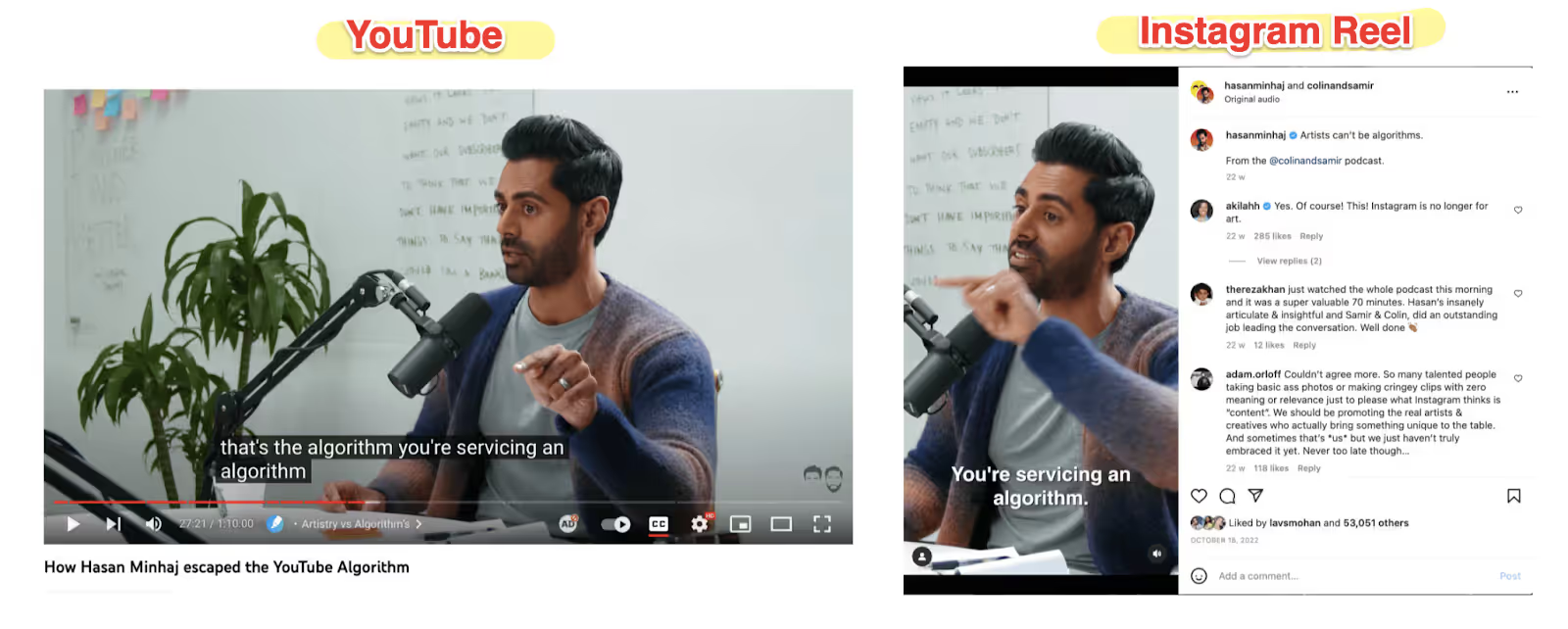
Depending on the type of content you create, it might be easy to recycle your long-form YouTube videos to Instagram Reels.
7 tips and best practices for better Instagram influencer collaborations
Run giveaways to boost sales, followers and traffic
Pro influencer marketers rate giveaways as one of the best influencer content formats for generating sales.
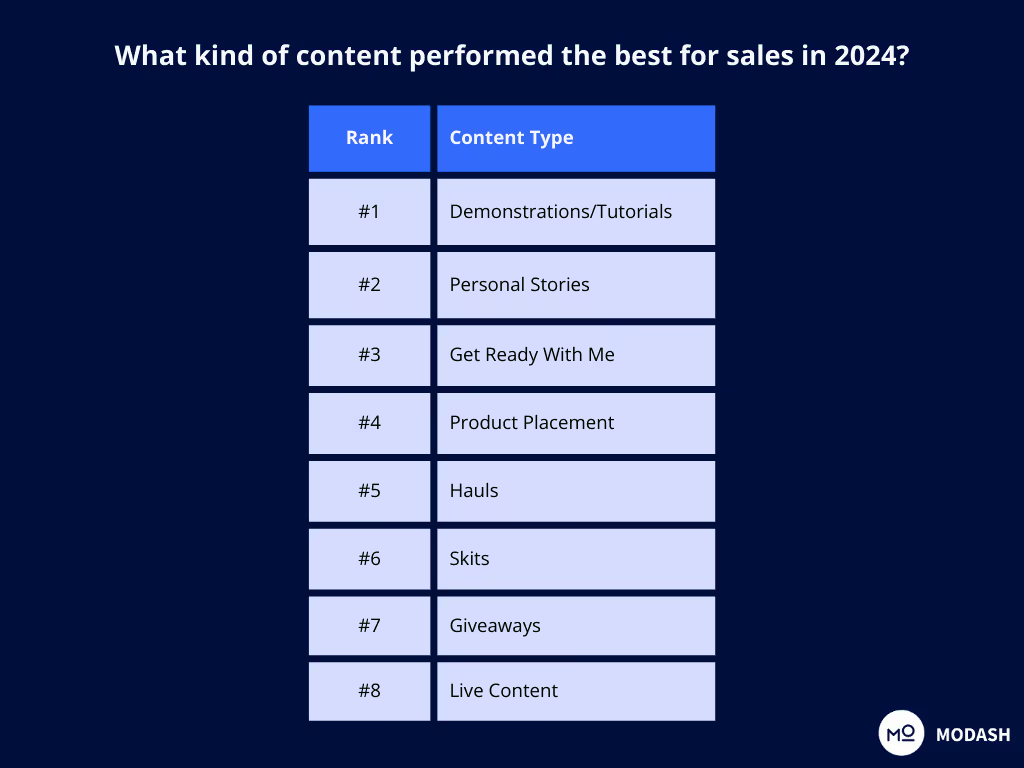
So you’ll be pleased to hear that giveaways are a natural fit for Instagram.
Marit Tiesema explained that giveaways aren’t just about conversions – they’re also highly effective for increasing website traffic and growing your follower count. Plus they’re a fantastic way to keep your influencer partners happy.
One word of caution – there are strict legal guidelines around the use of personal data in competitions, meaning the influencer needs to reach out themselves.
Leverage the functionalities of Stories to achieve different goals
Instagram Stories offer a bunch of interactive features that mean they’re well suited to achieving various influencer marketing objectives. Marit shared the following examples:
👉 Using Instagram Stories for product launches: Use a link sticker directing viewers to a landing page with a lead capture form for early access signup, or add a countdown sticker to build feelings of urgency and scarcity.
👉 Using Instagram Stories to remove barriers to purchase: If an influencer introduced your product, have them do a Q&A session after to address audience questions directly. Not only does this help overcome potential barriers, but it also provides fantastic insights for your own messaging.
👉 Using Instagram Stories to boost conversions: Add a discount code with a link sticker (using a Bitly link for tracking) that sends viewers straight to the product page.
Balance entertainment and impact
It stands to reason that entertaining content often gets the most views. This can be especially impactful with Instagram Reels, where the platform’s built-in virality means that once a post starts taking off, it’ll be served to an ever-wider audience.
However, Marit noted that views aren’t the be-all and end-all of influencer marketing – you need to keep your primary objectives at front of mind, too.
Prioritize Instagram for posts requiring longer captions
Long captions are way more of a thing on Instagram than other platforms, as chef Tom Sellers demonstrated in this collaboration with Birkenstock:

You can technically post captions of up to 2,200 characters on Instagram, giving you far greater scope for telling a story or sharing details about your latest product. So if you need to back up your visual content with a lengthy explanation, Instagram is definitely the platform for you.
However, Marit warned that you shouldn’t automatically default to writing novellas in your captions.
For starters, she noted that Gen Z-aged consumers tend to be “more visually oriented”, so they might not appreciate your epic captions. Also, in-feed post captions truncate at 125 characters on mobile – so you need to give people a compelling reason to keep reading.
Use static posts for aesthetic-driven content
Sure, static content isn’t an Instagram exclusive – it exists on TikTok, too. But static content on TikTok requires more of a storyline that viewers swipe through, almost giving it the effect of a video.
Instagram, on the other hand, has been doing this sort of content for as long as the platform has existed. Marit explained that static, in-feed posts – like lifestyle images and product shots – are “ideal for aesthetic-driven content”, making them a fantastic fit for niches like:
👉 Beauty
👉 Fashion
👉 Interiors
🤓 Pro tip: Can’t choose between single-image posts and carousels? Broadly speaking, Marit recommended prioritizing carousels, as they naturally encourage interaction – which can help deliver higher reach and engagement.
Exclude viral Reels when calculating average views
Calculating fees for Instagram Reels collaborations typically involves looking at the influencer’s average views. More views = more $$$.
But before you get out your calculator, remember to remove any viral outliers, as these can massively skew the results.
Or, if you don’t fancy doing all the math yourself, use Modash’s influencer profile reports.
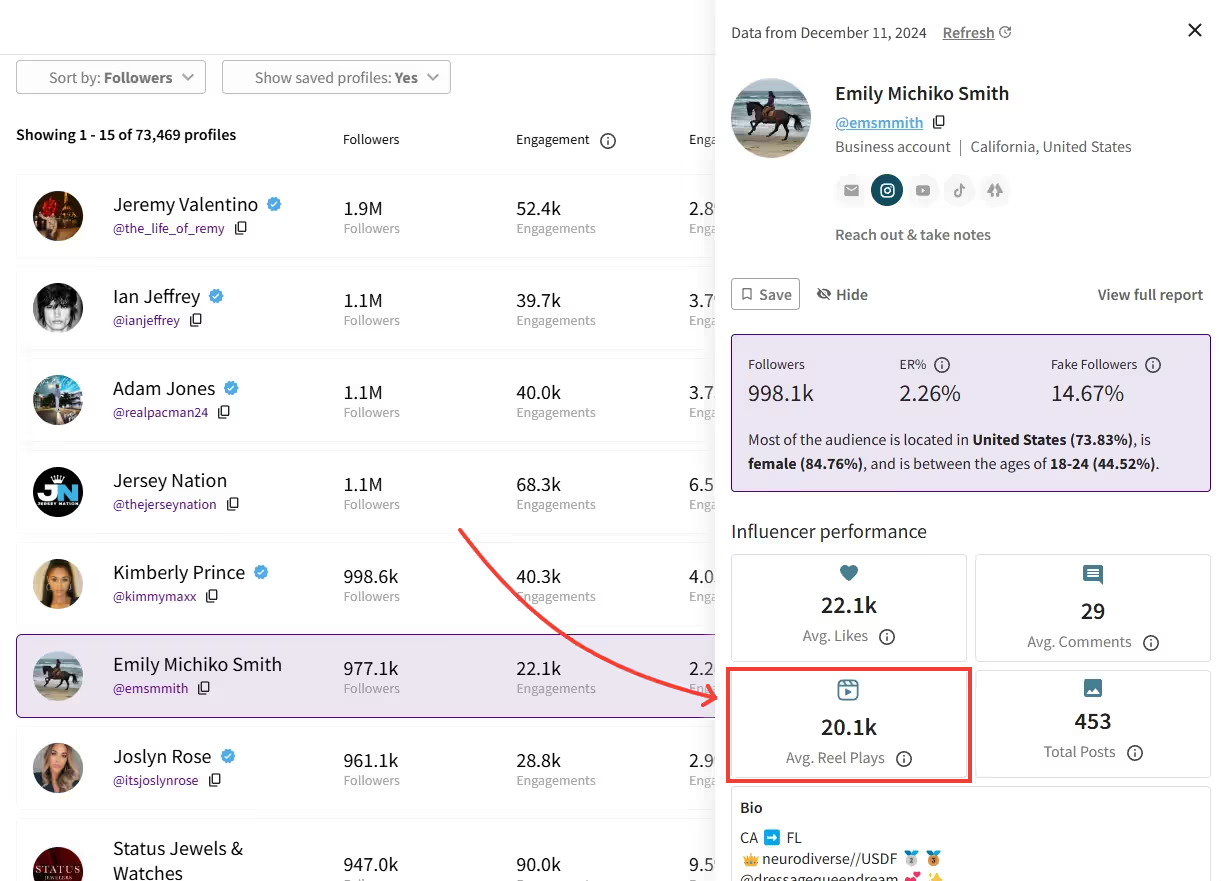
They contain average Reels views for every public profile with 1,000+ followers – and because we take the median rather than the mean average, the numbers aren’t influenced by the occasional piece of viral content.
👉 Put down your abacus and give Modash a try (for free!)
Steer clear of product-centric briefs
Sure, your ultimate goal is to sell more stuff.
But that doesn’t mean your Instagram briefs should be all about your product. People use Insta for entertainment – so if your influencer partner’s Reel or Story is nothing but product features and benefits, don’t expect viewers to stick around.
Your best bet for sharing must-watch content is to embed your product naturally.
For instance, a brand making headphones for runners could collaborate with a fitness influencer preparing for a marathon. Midway through their Reel, they mention that they’re wearing the brand’s headphones because they’re lightweight and offer superb sound quality – perfect for soundtracking those long, lonely runs.
It’s still a product promotion, but it doesn’t feel like an ad.
Ask influencers about their content calendar to help identify opportunities for this sort of seamless integration.
🤓 Further reading: Find more advice from the pros in Instagram Influencer Marketing: 10 Unique Tips.
How to run an Instagram influencer marketing campaign in 7 steps
Step 1: Get crystal clear on your goals to set yourself up for success
Obviously, clarifying your goals is an essential part of any influencer marketing campaign, regardless of platform.
I won’t get into the weeds of goal-setting here – for more on that, check out our guide to influencer marketing goals and KPIs. Instead, I’m going to focus on managing expectations about what Instagram can actually do.
Instagram’s three content types – in-feed posts, Stories, and Reels – are suited to delivering different goals. So if your campaign’s going to achieve the desired results, you need to choose the right format (or mix of formats) based on the three most common influencer marketing objectives:
👉 Generating content
👉 Building brand awareness
👉 Driving direct sales
As such, it often makes sense to bundle multiple content types into a single Instagram influencer collaboration. Not only will it help you achieve several goals in a single campaign, but ordering in bulk can help you negotiate a better price (more on this later).
Anna-Maria Klappenbach noted that the whole purpose of bundling content is to hit as many audience touchpoints as possible.
Step 2: Find relevant Instagram influencers who can help you hit your goal
Finding perfect Instagram influencers is where most brands need help. But it doesn’t have to be so complicated and daunting if you use influencer search tools like Modash. Using technology is reliable, efficient, and scalable. Modash has over whopping 71M Instagram creators – it lists every creator with 1,000+ followers in every niche, country, and city. 🤯
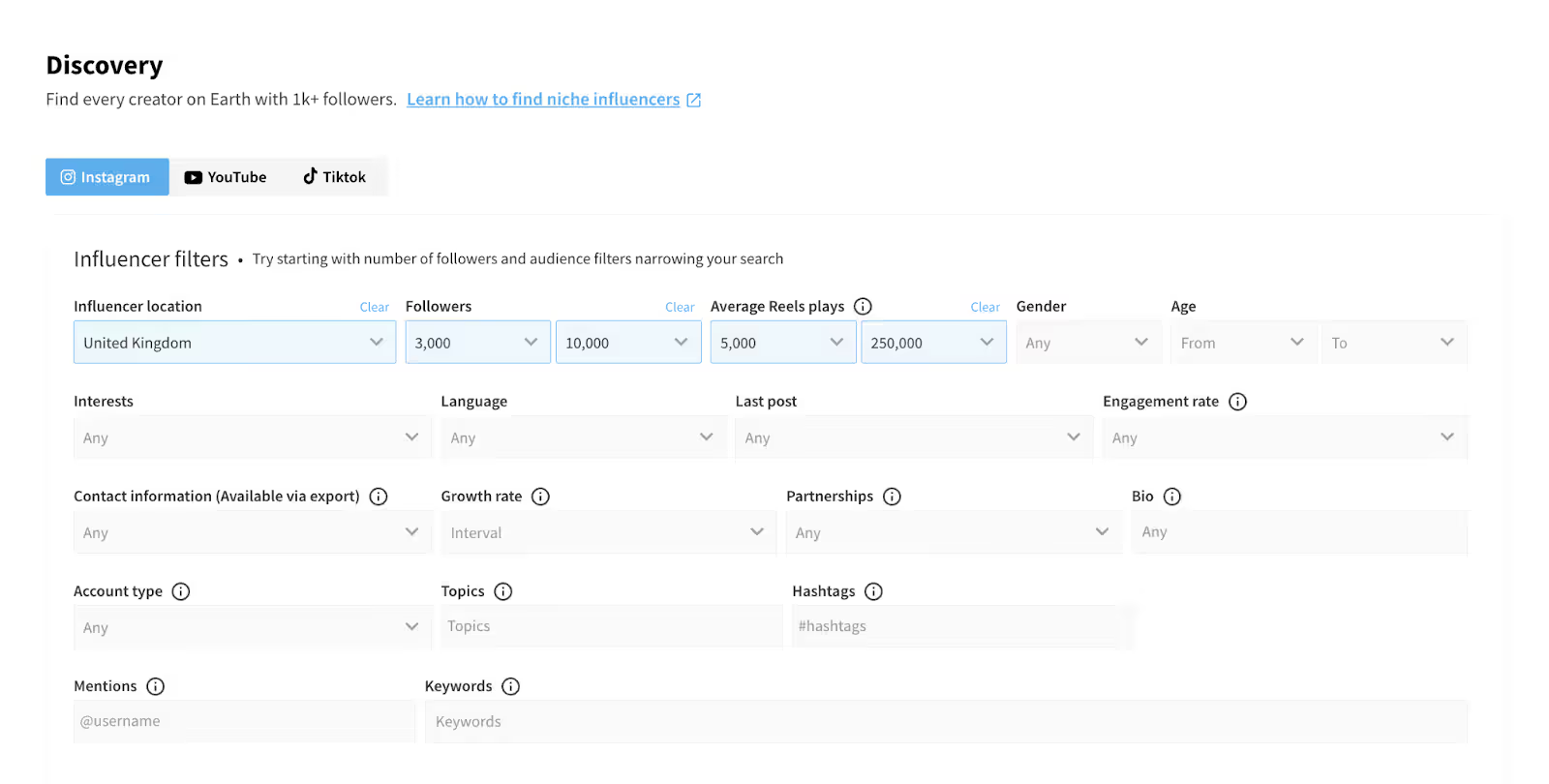
You can add various audience and influencer filters, such as follower range, location, average Reels play, and more.
Not just this: Modash’s influencer analytics tools also let you check an influencer’s audience demographics, post performance, top content, engagement rate, and more – without ever reaching out to the creator.
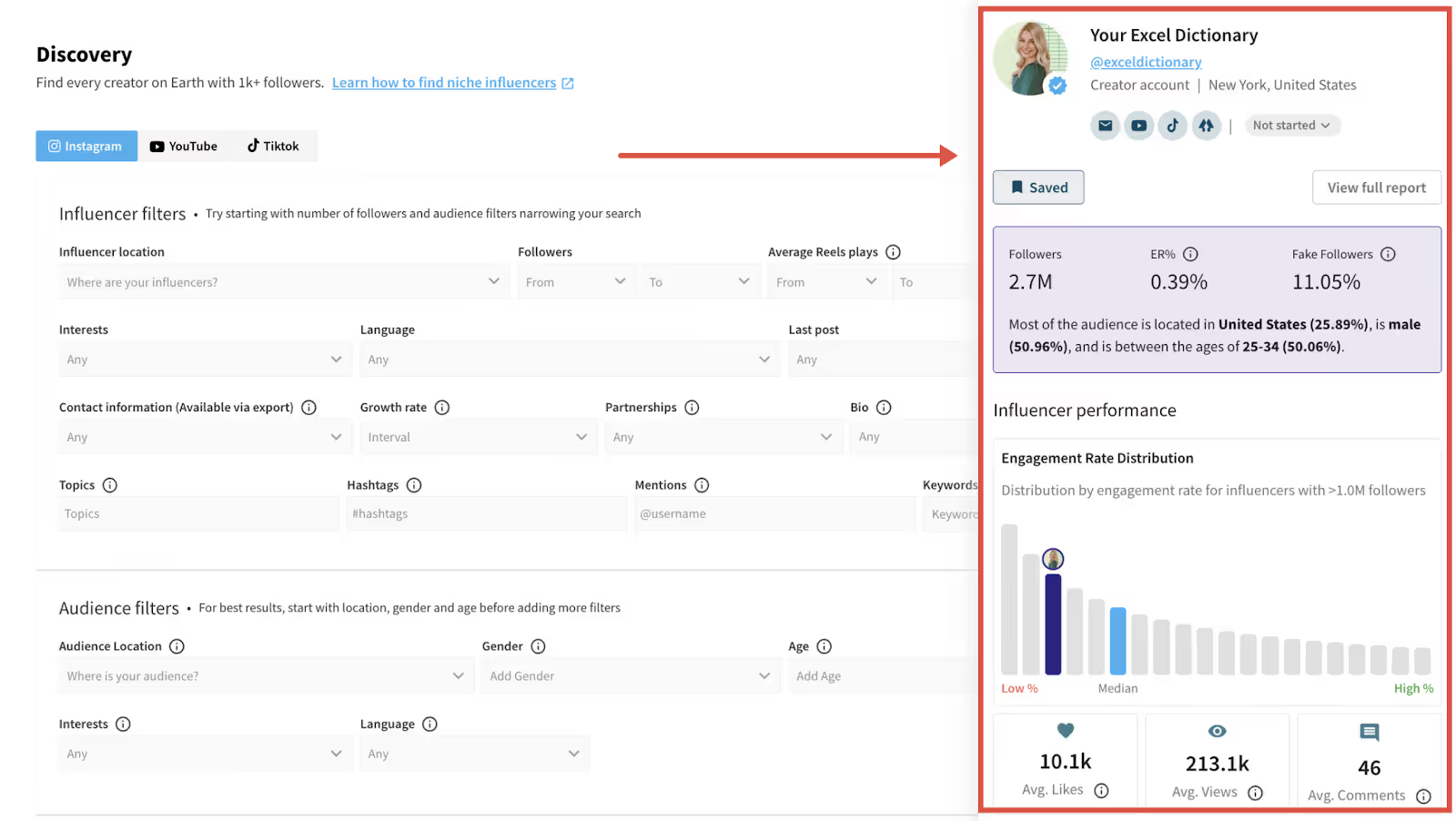
Test it at no cost: your first 14 days are on me. 😉
Looking for additional ways to find Instagram influencers? Here are five things you can try:
👉 If you have already done the legwork of finding TikTok influencers or finding YouTube creators, check if they have an Instagram presence. Many influencers develop audiences on multiple platforms and would be willing to cross-promote content on other channels for your brand at an additional cost. This partnership will be easy since you both already understand the work and requirements.
👉 Use the Instagram app and search for influencers using industry-relevant hashtags and keywords. For example, if you’re a beauty brand, search for #beautyproducts and the “beauty” keyword on the Instagram app.

But this process is a bit manual and time-intensive since you have to manually comb through each influencer’s profile. And you still have to use an influencer analysis tool to get their engagement rates, followers’ demographics, and more.
👉 If you already know an Instagram influencer you love, find similar creators using Modash’s influencer lookalike tool. For instance, Modash lists over 12K similar influencers to my favorite creator, Laura.

👉 Ask for referrals from your existing influencer partners (if any). Even TikTok and YouTube creators might have references for Instagram influencers.
👉 Search on Google (or even ChatGPT) to find a list of Instagram creators in your niche. Remember to be specific for better results.
💡 Learn more: 11 Ways To Find Relevant Instagram Influencers For Your Brand
Shortlist Instagram influencers you like and want to partner with. Next, tackle your outreach game to get a yes from them.
Step 3: Outreach to influencers to start a collaboration
Asking an influencer to promote your product looks easy on the surface. But creators (especially good ones!) are in high demand today. They’re picky about who they partner with because they don’t want to damage their own brand.
Again, I’m not going to deep-dive on how to do influencer outreach here – we’ve covered it all before.
Instead, I’d urge you to remember that Instagram influencers want to be treated like valuable brand partners, not names in a spreadsheet. Personalize your outreach to make it clear why you’re reaching out to them and how you think they, specifically, can help your brand.
For example, imagine you do influencer marketing for a Shopify store selling scented candles. You’re interested in working with influencers in the wellness space (obvious fit, right?) and you come across Hannah Weir, who posts a bunch of mindful content – some of which involves candles.
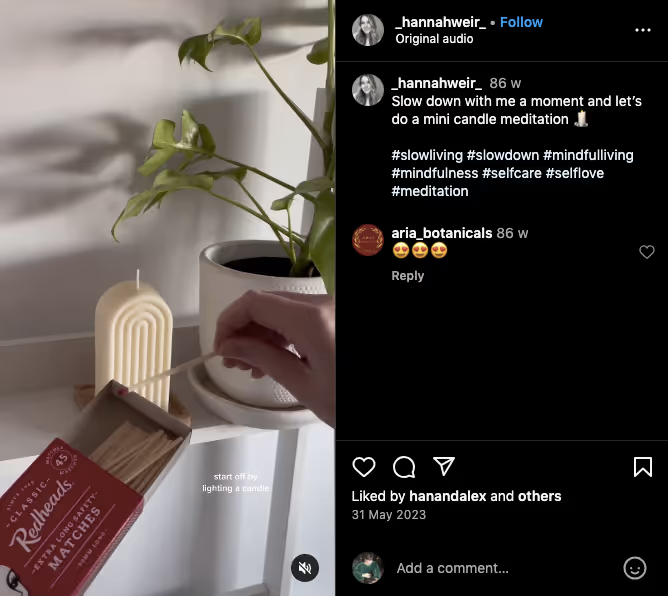
Bingo!
So you’d reach out saying something like:
Hey Hannah!
Your post about doing a mini candle meditation came across my Insta feed – I loved how you said that simply listening to the sounds of striking a match and lighting a candle can help you keep in the moment. Gonna start doing that myself!
It inspired me to reach out to you about ZenFlame’s new mindfulness-inspired scented candle. Could I send you a sample?
🤓 Further reading: Get more outreach inspiration in our roundup of real-world influencer outreach examples.
Of course, before you reach out to a high-potential influencer, you need to find their Instagram email address. There are two ways to do this:
👉 If you’re using the Instagram mobile app (very laborious), see if the influencer has their email available on their profile.
👉 If you’re using Modash (recommended), you can easily save the influencers you’ve shortlisted > create their list > and export their contact details. Three clicks, and your job is done.
⚡ Pro-tip: Don’t forget to follow up with unresponsive influencers at regular intervals. Emails often get lost and there’s no harm in a gentle nudge.
And Modash doesn’t just speed up the process of tracking down those elusive email addresses.
We’ve also built a better inbox for influencer marketing managers, designed to help you send more impactful outreach emails in less time.
For instance, you can view the status of a campaign or conversation right next to the influencer’s name…
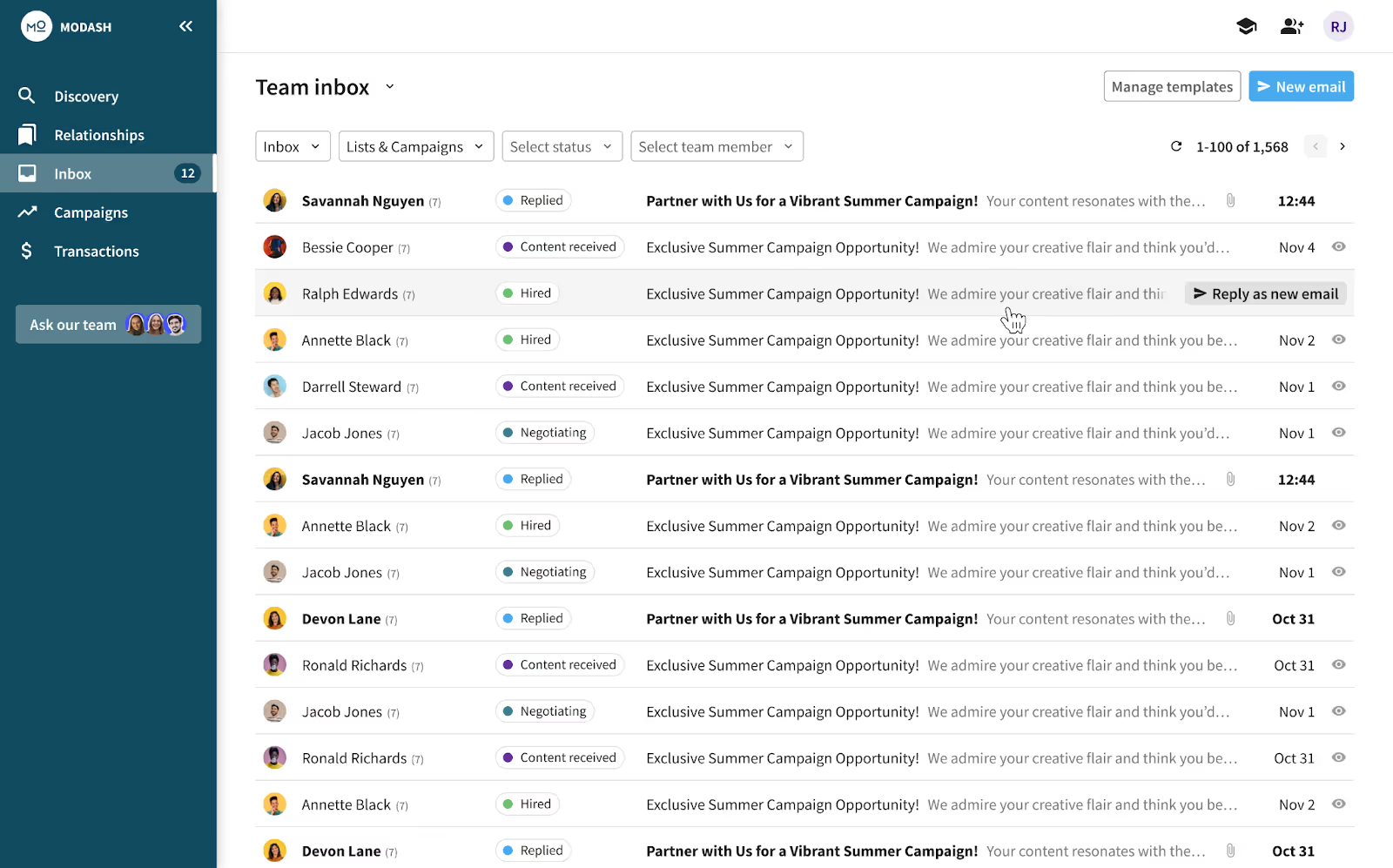
…and see a breakdown of all your information about an influencer – including any past or in-progress conversations – in the sidebar when you’re writing a new message:
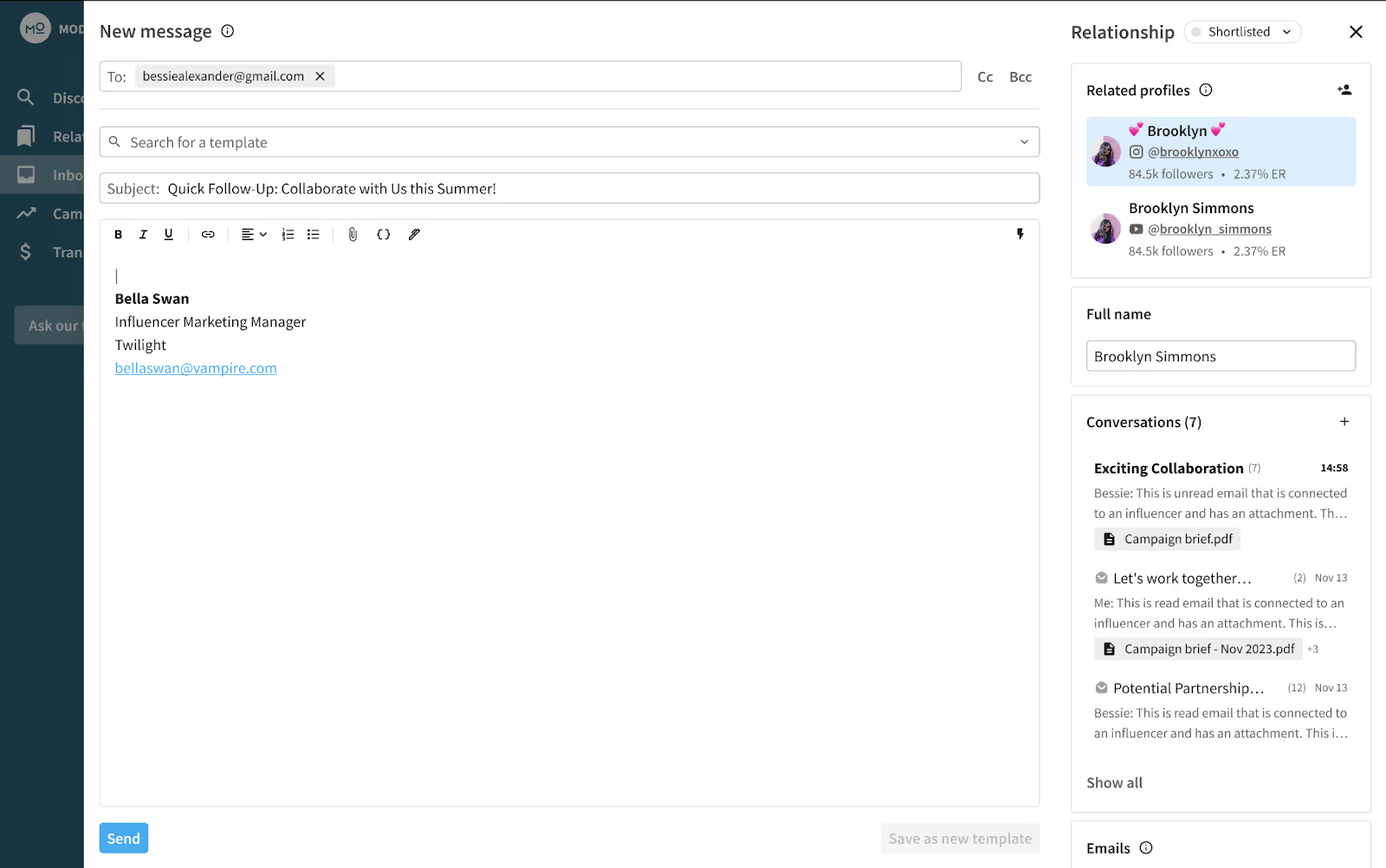
Plus it integrates with your existing Gmail or Outlook account, so you don’t have to worry about checking yet another inbox.
And that’s just for starters.
I could list every single feature, but it’s better to check it out for yourself with a 14-day free trial – no credit card details required 💅
Step 4: How to contract and negotiate for Instagram
Behind every successful Instagram influencer marketing campaign are a gazillion admin things done right.
First up, let's talk contracting. For a list of general tips and essentials (plus a killer contract template), check out our guide on what to include in an influencer contract. Beyond that, there are some Instagram-specific factors you should know.
Marit Tiesema recommends creating three versions of your contract templates:
👉 Template #1: Organic usage only. For partnerships requiring only organic content from influencers, without paid amplification or extended usage rights. This eliminates the need for frequent clause modifications.
👉 Template #2: Paid usage included. Covering both organic and paid content usage. Ideal for campaigns with no specific exclusions or restrictions.
👉 Template #3: Brand partnerships. Specific to collaborations involving partners, ensuring that the influencer’s content aligns with both brand and partner values, and that the influencer agrees to avoid negative comments about the partner.
🤓 Pro tip: Should one of the above include an event or trip, ensure your Influencer is solely responsible for obtaining and maintaining insurance policies.
This should be enough to cover most eventualities, without forcing you to scroll through a folder-full of contract templates every time you want to onboard a new influencer, Marit explained.
Given the range of deliverables on Instagram, you’ll definitely want to specific the exact formats for your campaign, plus related details like:
👉 Whether links or discount codes are required
👉 Specific tags and hashtags to use
Beyond that, Marit recommends referring to email communications or campaign briefings for creative guidance and timelines, rather than cramming your contract full of granular details. These aspects are often subject to change, so making them a fixed part of the contract could actually slow down the process.
Step 5: How to price for Instagram
Ahhh, the thorny issue of pricing.
I spoke to three pro influencer marketers in my in-depth guide to Instagram influencer pricing. Fact is, like so much in the world of influencer marketing, there’s little standardization around prices, with massive variations between different niches and locations. All of which makes it hard to share ballpark figures.
However, I rounded up the following estimates for US pricing, largely based on the home and lifestyle categories:
🤓 Pro tip: Negotiating a bundle of multiple deliverables typically results in discounts of 10% – 30%.
Prices can also be affected by factors like exclusive influencer partnerships, usage rights, and the number of frames in a Story.
The bottom line is: if there’s only a small number of Instagram influencers talking about the themes you want to discuss, you’ll likely have to pay more.
Step 6: How to brief for Instagram
Instagram briefing varies widely based on the specific deliverables you’re looking for – because Reels, Stories, and in-feed posts are very different formats. However, there are a few common threads:
👉 State your campaign goal: Influencers need to know whether you’re targeting awareness, sales, or something else. Consider sharing examples of effective CTA copy to ensure you and your influencer partner are on the same page.
👉 Provide content examples: Real-world examples are a valuable source of content inspiration for influencers. This could include hooks, specific wording, or full Stories/Reels/in-feed posts.
👉 Align your brief with the influencer’s style: Don’t ask influencers to use a content format they’re unfamiliar with, or crowbar in your own branding at the expense of their own style and aesthetic.
👉 Ask for concepts upfront: The best way to feel confident that your influencer partner is on the right track is to request concepts or storyboards for you to sign off before they start creating your campaign content.
👉 Remind influencers about FTC compliance: If they’re not using the Paid Partnership Disclosure tag, they must include the words “Ad” or “Sponsored” clearly in their content (including in each frame of a sponsored Story).
Other than that, don’t be too prescriptive. Sure, you want the influencer to deliver on-brief content, but you also want them to bring their unique tone of voice to your campaign – that’s the whole point of influencer marketing, right?
🤓 Further reading: For a (much) more in-depth guide, check out our article on influencer briefing for Instagram.
Step 7: Track live influencer content
Let’s be frank – keeping track of live influencer content is a massive headache when you have to do it all yourself. Even if you’re only working with a handful of influencers, pasting links and screenshots into spreadsheets and folders gets real old, real fast.
Modash takes all the pain away by reliably collecting live influencer content, whether you’re collaborating with half-a-dozen influencers or thousands.
And yes, that includes collecting Stories – so you don’t have to rely on snapping screenshots during the 24 hour-window when they’re live 😅

Modash also lets you create Shopify UTM links and promo codes in a few clicks (or connect existing codes to influencers), then track click-throughs, code redemptions, and total sales in the Modash dashboard.

If only everything was that easy!
Step 8: Nurturing influencer relationships to keep your creator partners happy
If your relationship with an influencer is purely transactional, there’s little incentive for them to go the extra mile for your brand.
That’s why you should take the time to delight your influencer partners.
There are lots of ways to do this – we rounded up our favorite general tactics in our guide: How to Build Great Influencer Relationships. But there are also some Instagram-specific methods you can use.
For example, if you’re running an influencer gifting campaign on Instagram, go out of your way to make it feel special. Andreea Moise (AKA the Hype Maven) recommended creating influencer-friendly packaging, like when a perfume brand she worked with designed a minimalistic box containing the message: “Words can never tell the stories fragrance can.”
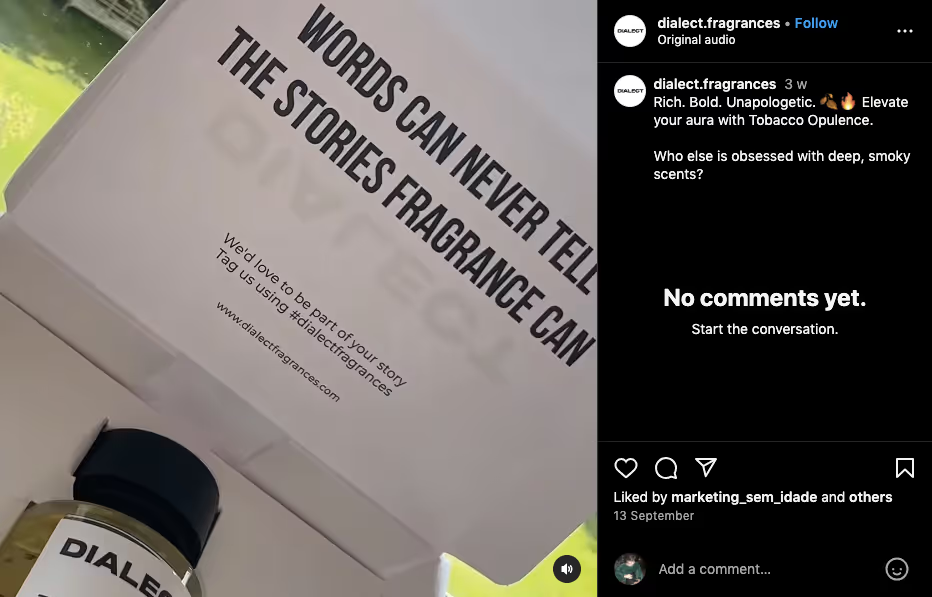
This low-cost tactic played super well with influencers, Andreea recalled. “When they received it, they were like, ‘Oh my God, let me take a snap.’”
Of course, there’s more to delighting influencers than snazzy packaging. You could also try:
👉 Inviting influencers to events and sneak peeks so they feel like a part of your team, not just a freelancer
👉 Running an influencer whitelisting campaign using their content to help them reach a wider audience and grow their following
👉 Using Modash to manage influencer payments so it’s easy for your influencer partners to get paid
Just a little extra effort on your side can go a long way to building mutually beneficial long-term influencer relationships.
3 Instagram influencer marketing campaigns done right
Let’s look at what successful Instagram influencer marketing looks like in action. Here are three examples to inspire:
1: CHARLES & KEITH
User-generated content (UGC) plays a key role in Singaporean fashion house CHARLES & KEITH’s promotional strategy. That’s a smart move given that customers who interact with UGC convert at a 102.4% higher rate than the average shopper.
They showcase their best Instagram UGC on their homepage and a dedicated campaign landing page where customers can shop the various lewks:
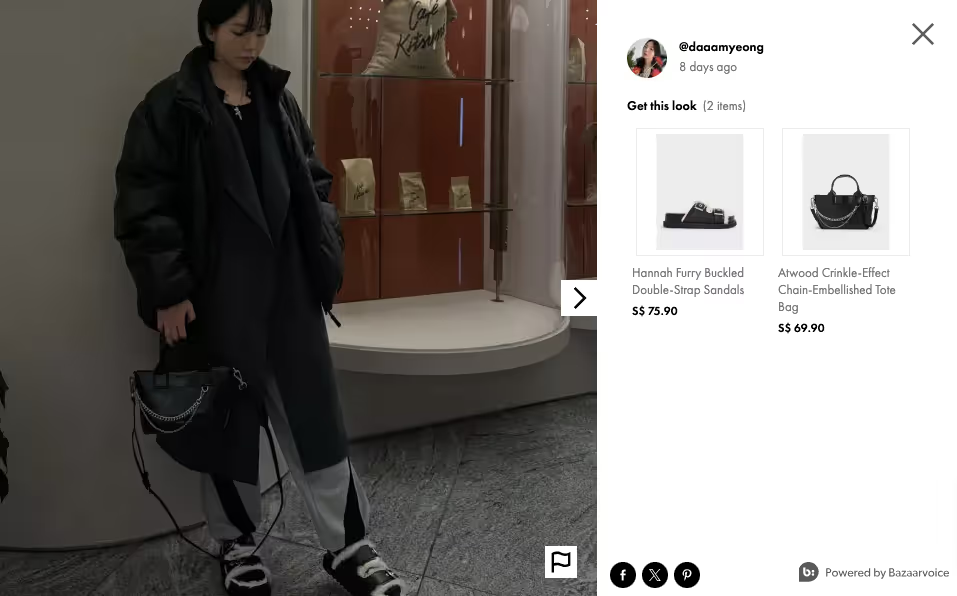
But how do they keep the user-generated content pouring in?
Simple: they use a dedicated hashtag (#ImwithCharlesKeith) for gathering UGC. Then they promote the hashtag through sponsored content campaigns, like the below example featuring Instagrammer Tia Dewitt:
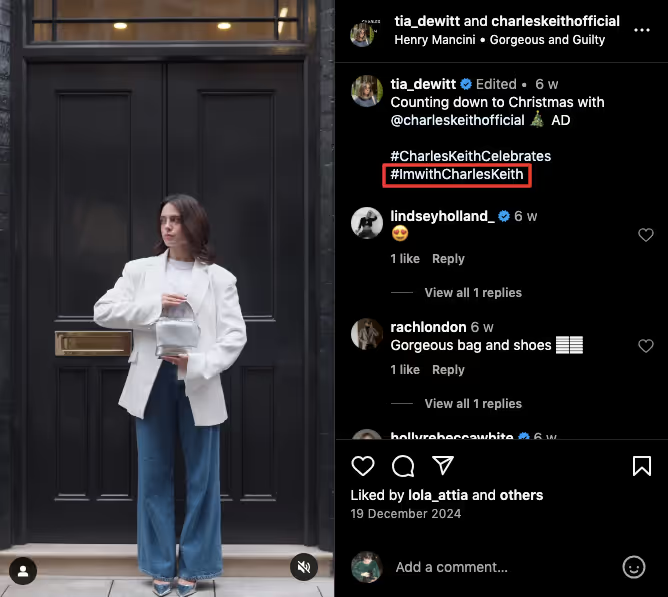
When Tia’s fans see her using the hashtag, they’re inspired to get involved themselves, resulting in more UGC for CHARLES & KEITH.
The results?
🎉 At time of writing, there are close to 55,000 posts on Instagram with the hashtag #ImwithCharlesKeith
🎉 Some of those posts (like this one) have thousands of comments and likes.
🎉 Because UGC is shoppable via the CHARLES & KEITH website, it has a direct impact on sales as well as generating brand awareness.
Key takeaways:
✅ Leverage user-generated content to build brand trust, reach new audiences, and boost sales.
✅ Create a dedicated hashtag to gather all your UGC.
✅ Run paid influencer collaborations to promote your campaign hashtag, helping you build a consistent stream of UGC.
2: Dove’s #TheCROWNAct collaboration with Instagram influencers
Dove sells hair products. But they stand for much more than that. They support various social causes in collaboration with influencers on Instagram and share stories through their profile.
In one example, they partnered with multiple influencers – including Chanel – for their Crown Act. This campaign shares stories of real women who faced hair discrimination in the workplace and took a stance against it.
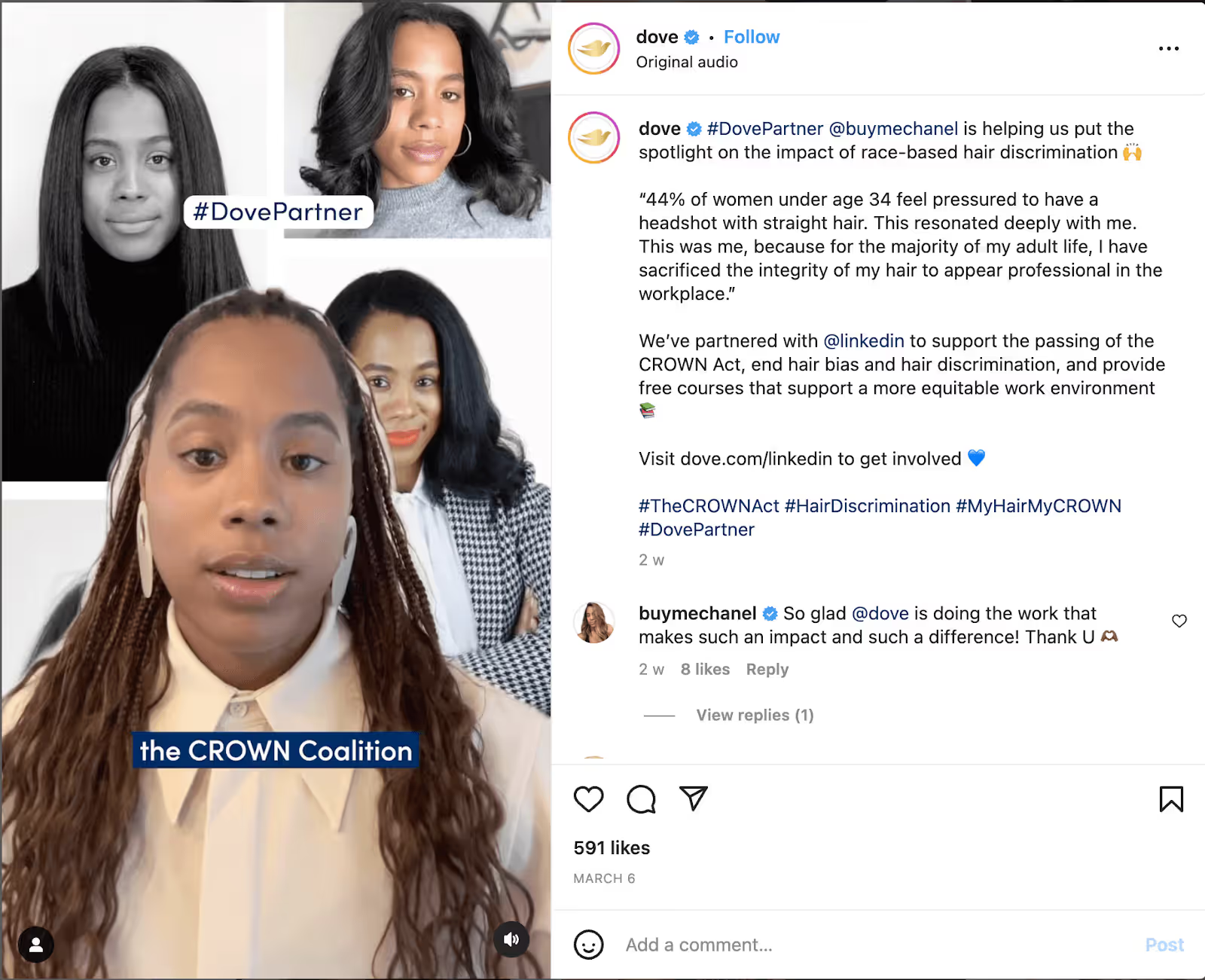
The result?
🎉 #TheCROWNAct hashtag has 23K+ Instagram posts.
🎉 All posts related to this campaign have a minimum of 20K views on Instagram Reels, with one post generating 338K views.
🎉 The comments on this campaign’s posts are highly appreciative of Dove and the impact they’re making with their influencer partnerships.
Key takeaways:
✅ Use Instagram influencer partnerships to highlight your brand values and mission.
✅ Share your Instagram influencers’ and brand ambassadors’ personal stories on your profile to forge a stronger relationship and create more authentic content.
✅ Almost all creators Dove partnered with for this campaign have under 30K followers, which goes to show the importance of relevance over a large distributed following.
3: Touchland’s Instagram influencer gifting strategy
Touchland sells scented hand sanitizers, which are the choice of hand cleaning from the likes of Kris Jenner, Mandy Moore, and even Kate Hudson.
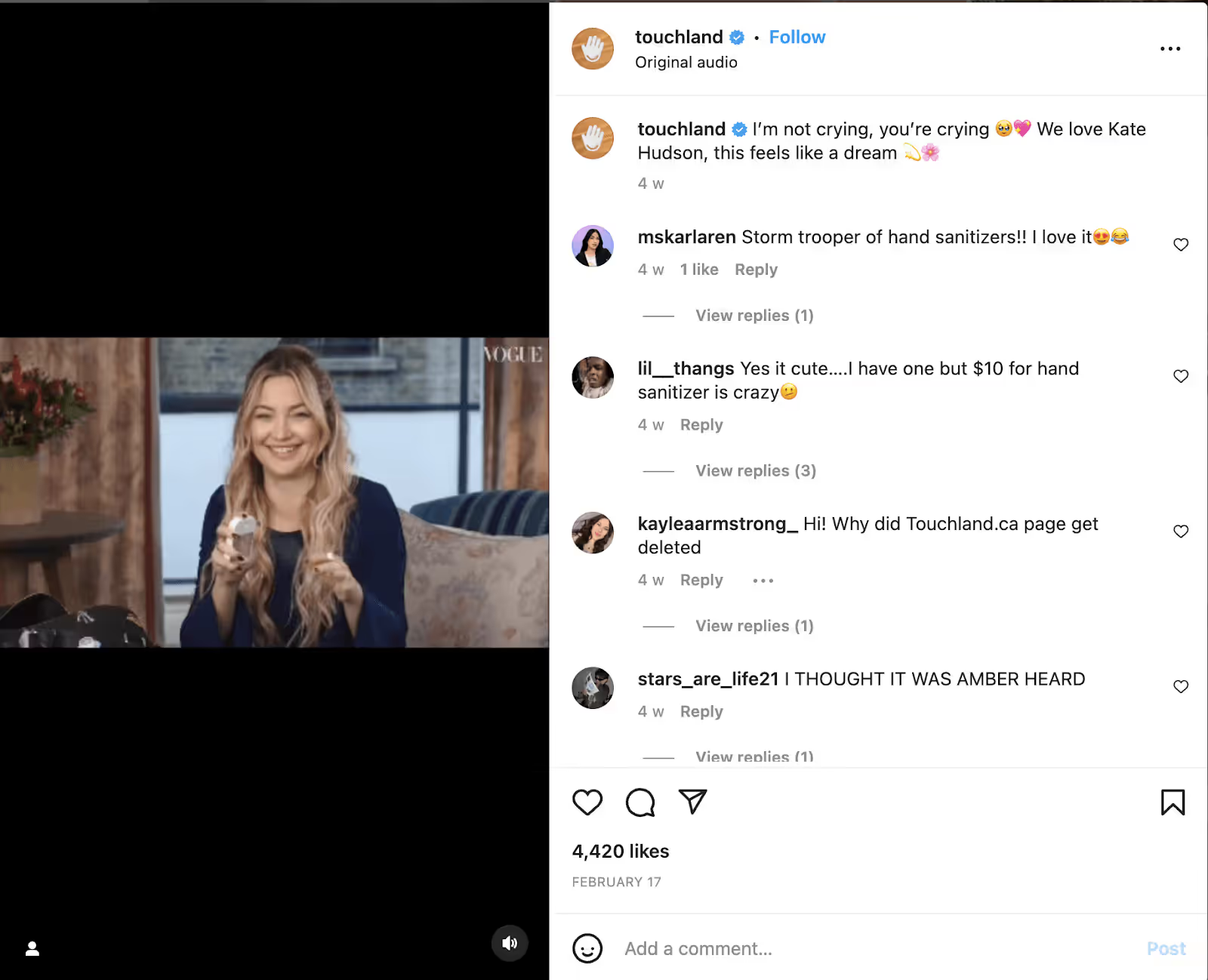
But how does Touchland get these A-list celebrities to discover its products? Influencer gifting. It might sound like a far shot, but the founder regularly reaches out to beauty bloggers herself, shares her story, and asks them to share honest reviews — which led to their products being discovered by celebrity makeup artist Jamie Greenberg. Then, a domino effect followed.
The results?
🎉 Popular A-list celebrities started using Touchland’s hand sanitizers, boosting its brand awareness and press.
🎉 Given the celebrity backing, Touchland could easily position itself as a beauty product and charge $10 for its hand sanitizers.
🎉 Touchland continues to partner with various micro-influencers via influencer gifting, which means they’re not spending a dime except COGS and still getting fantastic ROI.
Key takeaways:
✅ Methods like influencer gifting and product seeding might require more hustling, but the payoff is huge.
✅ Aesthetics matter — create a memorable unboxing experience and pretty packaging.
✅ Leverage your Instagram influencer marketing success to position yourself at a premium.
🤓 Further reading: 17 Influencer Marketing Campaign Examples [+ Key Takeaways]
Would you do it for the ‘gram?
Instagram influencer marketing is increasingly becoming necessary for e-commerce businesses. With this guide under your reference, you know exactly the steps you need to take to master the process.
But it can still be overwhelming — finding influencers, experimenting with collaboration types, tracking ROI, and so much more. Streamline it all using Modash and get some significant tasks — like finding Instagram influencers — off your plate.









